Dogs in Art
written by Nicholas Skeaping
Terrier, Corgi, Dachshund, Poodle, Pug, Boxer, Shiba Inu, German Shepherd, Greyhound or Mongrel. The breed really does not matter, dog owners will love them all unconditionally, treating them as family members. Read our article and unravel the dog-human relationship through the history of art.
Cassius Marcellus Coolidge, Poker Game, oil on canvas, 1894. Image: Wikipedia / License: Public Domain
Dogs have through the ages been popular subjects in art, dare I say even more so than cats and in this article I would like to discuss a few examples of that oeuvre. Most but not all of the images we are going to look at will be familiar to readers. Dogs have been depicted as individual subjects, as part of a pack or as props in pictures, and in all cases their presence enhances the work and adds value.
Early Depictions of Dogs in Art
Dogs have been depicted from the very early development of art and the domestication of the animal there being examples of funerary statues of dogs from ancient Egypt and Greece, the dog often seen as the guardian of the dead as well as the living. The dog is also depicted in Central American civilisations [Cotes de l’Occident] but arguably the beast was not as important as other animals in the lives of humans except for specialised uses like guarding and hunting. As painting and tapestry developed and the relationship between dogs and man became a companionship so too did the place in art of canines increase. From these formative years I would like to concentrate on a few paintings before writing about better known ‘dog’ paintings.

Cave canem (Beware of the Dog) , Roman mosaic at the entrance to theHouse of the Tragic Poet in Pompeii, Italy, 2nd century BC. Image: Sailko / License: Public Domain
"Dogs have been depicted from the very early development of art and the domestication of the animal there being examples of funerary statues of dogs from ancient Egypt and Greece, the dog often seen as the guardian of the dead as well as the living. "
Dogs in Renaissance and Baroque Art
In Guido Reni’s [Italian 1575-1642] painting of 1626/9 in the Louvre L’Enlevement d’Helene there is a little black and white dog looking at what appears to be a monkey on a string. Just what the relevance is of the little dog and the monkey in the picture given the fate that Helene is facing is unclear but it adds a domestication to the scene as do her attendants one of whom holds a little spaniel. In Velazquez’ [Spanish 1599-1660] painting Las Meninas of 1656 we see a large dog affectionately caressed by the foot of one of the children. By now the dog has instilled itself in every day domestic life. Frans Snyders [Flemish 1579-1657] dogs are a good deal more savage whether attacking wild boar or fighting over stolen joints in the kitchen.
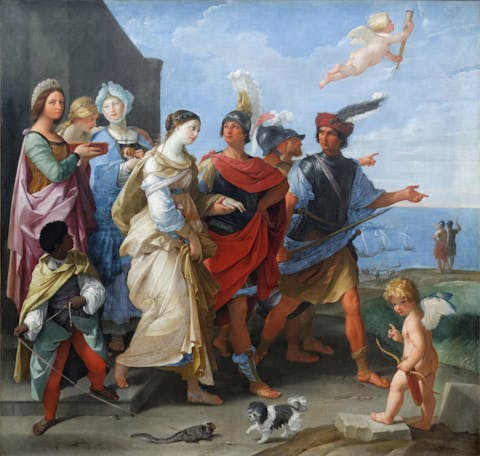
Guido Reni [Italian 1575-1642], L’Enlevement d’Helene, 1626/, Louvre, Paris. Image: Wikipedia / License: Public Domain
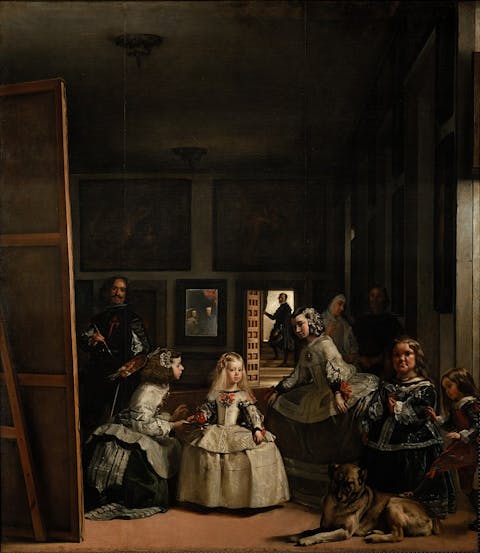
Diego Velázquez [Spanish 1599-1660], Las Meninas, 1565, Prado, Madrid. Image: Wikipedia / License: Public Domain
By the time we move onto the 18th century and artist’s like George Stubbs [British 1724-1806] the dog is still illustrated as part of the picture in some cases as with hounds next to their owner proudly seated on a horse but also in pride of place as individual sitters such as his wonderful Poodle in a punt of circa 1780. Thomas Gainsborough [British 1727-1788] also painted dogs and his Pomeranian bitch and Puppy from circa 1777 in The Tate is a masterpiece of dog art not expected from the landscape and portrait master.
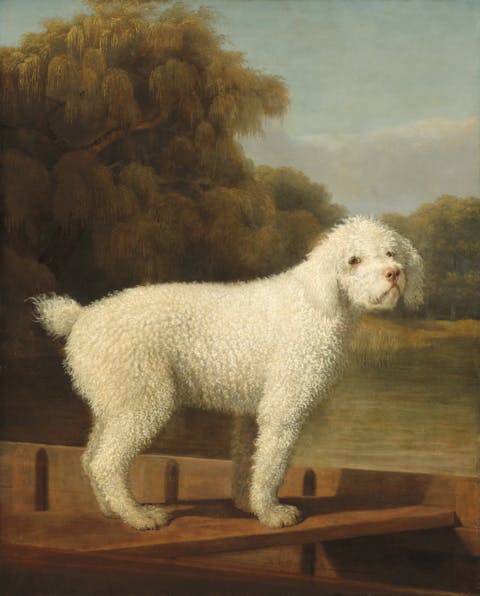
George Stubbs, (British, 1724 - 1806), White Poodle in a Punt, c.1780, National Gallery of Art, London. Image: NGA / Licese: Public Domain
On a grimmer note some of the works of James Ward [British 1769-1859] and Abraham Cooper [British 1787-1868] along with Charles Towne [British 1763-1840] would be extremely disturbing to dog lovers of today given they depict fighting both incidental and organised.
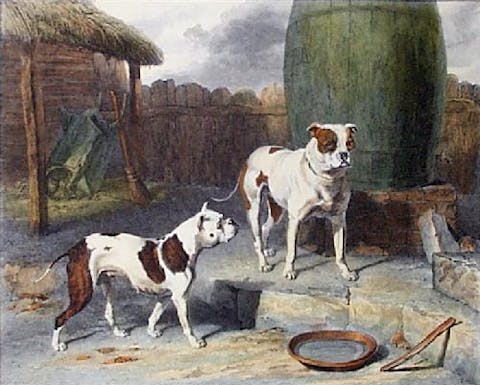
Abraham Cooper( British 1787-1868), Crib and Rosa, circa 1817, Image: Wikipedia / License: Public Domain
“Good Boy!”, Portraits of Beloved Dogs
None of these paintings are sentimental but that is not the case with many 19th century works some of which we will now look at. Edwin Landseer [British 1802-1873], Queen Victoria’s favourite painter, is known for so many fine dog paintings the entire article could have been about him. There is his 1831 painting A Distinguished Member of the Humane Society a Newfoundland dog that was more famous than the artist which is now back in The Tate having been restored. Other familiar titles include Dignity and Impudence from 1877: Suspense from 1834 in the V&A and There is no place like home from 1842 also in the V&A. There are many more but my favorite has to be of Prince Albert’s greyhound Eos from 1841 which to me looks more like a whippet but I, like many dog owners, am breed prejudice. It is worth pointing out here that specific breeds can perform in auction better than some others but fashions in dogs are evolving all the time as they are in art. There was a time when hunting hounds were favorites along with little breeds like Cavalier Prince Charles Spaniels but now, whilst there is no exact science to the subject, whippets are as sought after as any breed.
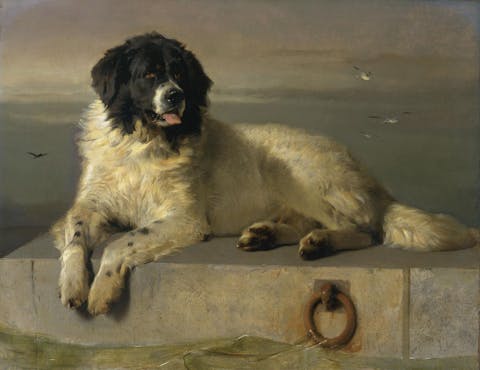
Sir Edwin Landseer (British 1802-1873), A Distinguished Member of the Humane Society, Tate Collection, London. Image: Wikipedia / License: Public Domain
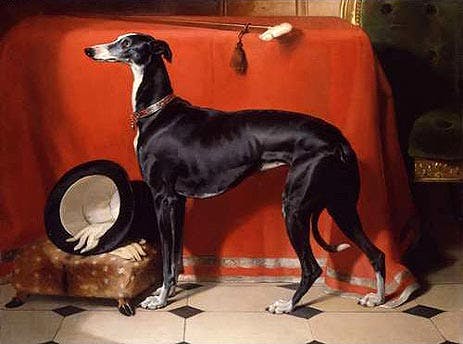
Sir Edwin Landseer (British 1802-1873), Eos, A Favorite Greyhound of Prince Albert, 1841, The Royal Collection London United Kingdom, Image: Wikipedia / License: Public Domain
" It is worth pointing out here that specific breeds can perform in auction better than some others but fashions in dogs are evolving all the time as they are in art. "
Art Auctions and Dog Sales
Bonham’s Auctions used to have annual ‘Dogs Sales’ firstly in Knightsbridge and later in New York along with Doyle's and there the popularity of specific breeds was as important as the standing of the artist of the work. Back to the 19th century it is worth looking at the height of sentimentality in dog pictures by the works of Charles Burton Barber [British 1845-1894] and Arthur John Elsley [British 1860-1952] both of whose paintings made very large sums in auction at the height of the ‘Victorian’ picture market. They have dropped a little of late in expectations in auction along with much from the period but for ‘chocolate box’ sentimentality and quality of painting they cannot be bettered. Before leaving the 19th century I should mention a few other competent dog artists like John Emms [British 1849-1912] a foxhound specialist who also did wonderful hairy lurcher hunting dogs. Thomas Blinks [British 1860-1912 whose full cry hounds are full of movement and Arthur Wardle [British 1860-1949] whose terriers wait patiently by rabbit holes. More familiar to many Victorian painting fans will be the works of the Armfields, George [British 1808-1893] and Edward [1817-1896] both of whose terriers ratting paintings are less sought after then they once were.
Related: A Masterpiece by Queen Victoria's Favorite Animal Painter at Auction
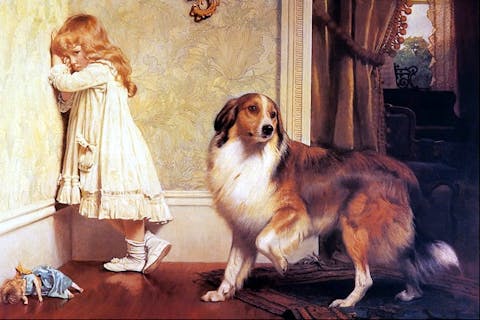
Charles Burton Barber (British 1845-1894), A Special Pleader, 1893. Image: Wikipedia / License: Public Domain
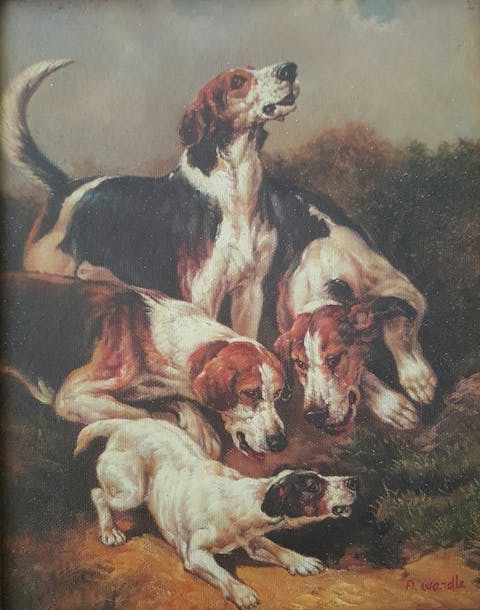
Arthur Wardle British 1860-1949), Hunting dogs, Private Collection, Image: Adamt / License: CC BY-SA 4.0
Dog Memes From The Past
There is humour in some dog paintings and various artists have specialised in that field like the wonderfully named Cassius Marcellus Coolidge [American 1844-1934] whose Poker Game dogs of 1894 is well known from reproductions. So too is the work of etcher Arthur ‘Boris’ O’Klein [French 1893-1985] whose ‘pissoire’ dogs are well known or would be if anyone could read the signature! I am sure there are many others but they lead us to the 20th century which is awash with dog art and most owners have got a portrait of their favourite pooch in their collection often done by very competent amateur painters. The Studio introduced a series of little books in The How to Draw series of which John Skeaping [British 1901-1980] was commissioned to do the one on dogs. In simple stages the artists showed how to paint or depict their chosen subjects and in his book Skeaping takes the reader through stages of how to draw various dogs both hairy and smooth coated; the poodle dominating the former whilst greyhounds and whippets were perfect for showing the form of the anatomy of the smooth-coated breeds. Another artist whose love of his own whippet[s?] has featured extensively in his wonderful detailed paintings and drawings is Lucien Freud [German/British 1922-2011].
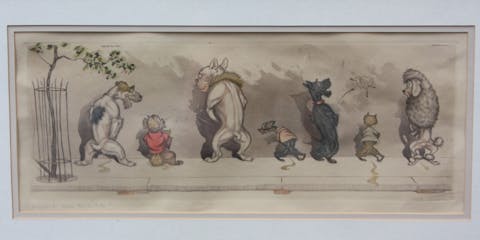
Arthur ‘Boris’ O’Klein (French 1893-1985),Comme nos maîtres (Like our masters). Image: Charles J. Sharp / License: CC BY-SA 3.0
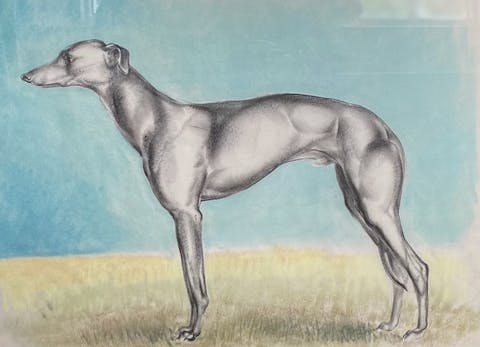
John Skeaping [British 1901-1980], Drawing of a Dog, c.1950. Image: Nicholas Skeaping/ Copyright: Estate of John Skeaping/Tate
You may not be able to afford a Freud painting but collecting dog art will not necessarily be an expensive business. Firstly decide if you are going to concentrate on a specific breed or an individual artist then feed that information into your search systems. Now if you choose a rare breed like the Irish Water Spaniel then works on the market will be few and far between and you may just want to choose the paintings of a specific painter. You will have a great many works to choose from if you focus on an artist like Marjorie Cox [British 1915-2003] or the more expensive and slightly less common Cecil Aldin [British 1870- 1935] but as with all aspects of collecting it is very much an individual choice and the only advice I will give is stick to good quality and condition along with value for money for your purchases and be aware that not everyone cataloguing dog paintings will be able to determine what breed is depicted: that Curly-coated retriever just could be an Irish Water Spaniel!
Related: Cats in Art: 10 Decidedly Feline Works
Nicholas Skeaping is the son of a famous British sculptor and painter John Skeaping RA. Our expert grew up in a house rife with art. He began his career in 1971 by converting an antiques shop into a Gallery to sell Victorian and Modern British paintings. Since then he has acquired forty years in the art world, travelling extensively throughout South Africa and South America in pursuit of ‘lost’ works.

